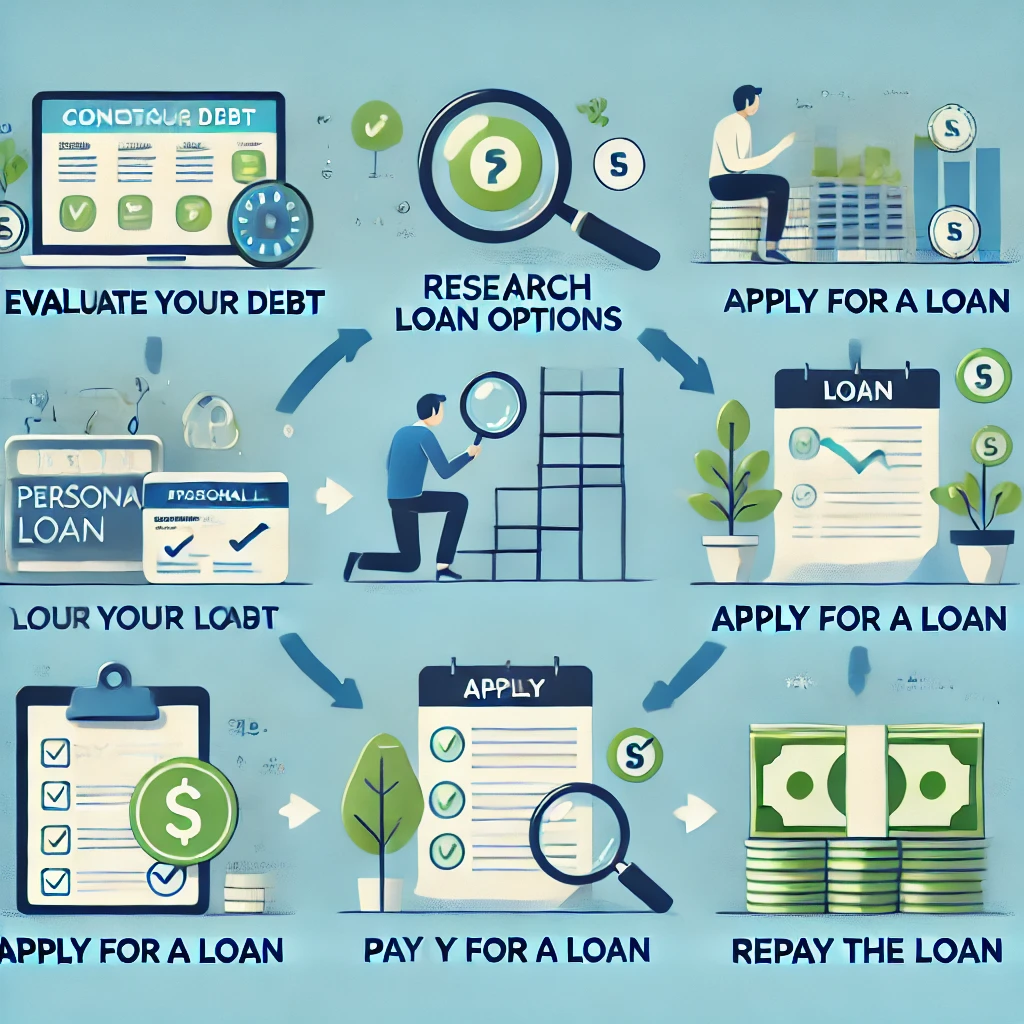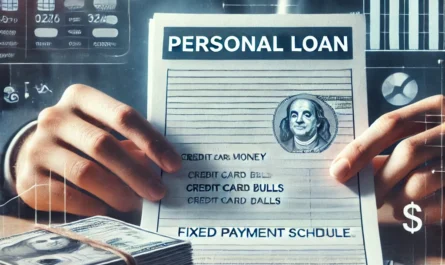Debt can often feel overwhelming, with multiple bills, varying due dates, and a mix of interest rates. If you’re juggling credit card debt, medical bills, or other financial obligations, debt consolidation can provide relief. One effective way to achieve this is by using a personal loan. This method offers you a structured repayment plan and often lower interest rates than high-interest credit cards.
In this guide, we’ll explore the advantages of debt consolidation, how to use a personal loan to consolidate debt, and tips for managing your loan successfully.
What Is Debt Consolidation and Why Consider It?
Debt consolidation is the process of merging multiple debts into a single payment, typically at a lower interest rate. This is particularly useful if you have various forms of unsecured debt, such as credit cards or medical bills. The goal is to simplify your financial situation, reduce your monthly payments, and save money on interest.
People consider debt consolidation for several reasons. First, it simplifies finances, allowing you to focus on one payment rather than juggling several. Second, it often reduces the overall interest rate, saving you money in the long run. Lastly, it can help improve credit scores over time by ensuring consistent, on-time payments on a single loan.
Why Choose a Personal Loan for Debt Consolidation?
A personal loan offers many benefits when consolidating debt. Personal loans usually come with fixed interest rates, fixed repayment periods, and no collateral requirements, unlike secured loans. Additionally, personal loans can be used for almost any purpose, making them versatile for debt consolidation.
Choosing a personal loan for debt consolidation provides:
- Fixed payments: This makes budgeting easier since you’ll know exactly what you need to pay each month.
- Lower interest rates: If your existing debts have high-interest rates (like credit cards), a personal loan could reduce the overall interest, especially for those with good credit.
- Single monthly payment: Consolidating multiple payments into one makes your finances more manageable.
- Improvement of credit score: Paying off revolving credit (like credit card balances) with an installment loan can positively impact your credit score by reducing credit utilization.
How to Consolidate Debt with a Personal Loan
Step 1: Evaluate Your Debt Situation
Before deciding on debt consolidation, take stock of your existing debts. List your outstanding balances, interest rates, and minimum monthly payments. This will help you determine whether a personal loan is a good option and how much you need to borrow.
Step 2: Research Loan Options
Different lenders offer varying terms for personal loans. Check both traditional banks, online lenders, and credit unions to compare interest rates, fees, and repayment terms. Personal loans are typically offered in amounts from $1,000 to $50,000, with terms ranging from 12 to 60 months.
Some factors to consider when choosing a lender:
- Interest rates: Make sure the loan’s interest rate is lower than the average rate of your existing debts.
- Loan terms: Look for repayment periods that match your financial goals. Shorter terms mean higher payments but less interest, while longer terms lower your monthly burden but could cost more in interest.
- Origination fees: Some lenders charge fees for processing the loan. Look for loans with low or no fees to maximize your savings.
Step 3: Apply for a Personal Loan
Once you’ve selected a lender, the application process is straightforward. Be prepared to provide:
- Proof of income (pay stubs, tax returns, or bank statements)
- Identification (government-issued ID)
- Information about your debts and financial history
Lenders will check your credit score and debt-to-income ratio. While a higher credit score will help you secure better rates, many lenders offer personal loans to borrowers with fair or average credit.
Step 4: Pay Off Existing Debts
Once approved, use the loan funds to pay off your existing debts. Be sure to clear all balances, particularly high-interest ones like credit cards, to make the most of the debt consolidation process.
Step 5: Focus on Repaying the Personal Loan
With your debts consolidated, all that remains is managing the repayment of your personal loan. Since personal loans come with fixed terms, you’ll know exactly how long it will take to become debt-free.
Make it a priority to stay consistent with your payments. Setting up automatic payments can help ensure you never miss a due date, which will protect your credit score and keep you on track toward full repayment.
Benefits of Consolidating Debt with a Personal Loan
Consolidating debt with a personal loan offers several key advantages:
- Simplifies repayment: Juggling multiple debts with different due dates and interest rates can be stressful. A personal loan consolidates everything into one manageable payment.
- Lower interest rates: Personal loans often offer lower interest rates than credit cards or medical bills, especially for borrowers with good credit.
- Boosts credit score: Paying off high-interest debt with a personal loan reduces your credit utilization, which can improve your credit score.
- Predictable monthly payments: Fixed monthly payments and terms provide clarity and reduce the risk of accumulating further debt due to fluctuating balances or missed payments.
- Freedom from revolving debt: Credit card debt, in particular, can feel never-ending due to its revolving nature. A personal loan, by contrast, provides a set endpoint for repayment.
When Is Debt Consolidation Not the Best Option?
While consolidating debt with a personal loan can be beneficial, it’s not always the best choice for everyone. Here are a few scenarios where it might not be the ideal solution:
- High debt-to-income ratio: If your total debt is very high compared to your income, a personal loan might not make a significant difference. In such cases, debt settlement or credit counseling could be better options.
- Bad credit: While personal loans are available to those with less-than-perfect credit, you might not qualify for a loan with favorable terms. If the interest rate on the loan is higher than your current debt, consolidating wouldn’t make sense.
- Lack of financial discipline: If overspending or poor money management led to your debt, consolidating could provide temporary relief but wouldn’t solve the underlying issue. Without addressing these habits, you risk falling into debt again.
Alternatives to Personal Loans for Debt Consolidation
If a personal loan isn’t the right fit, there are alternative debt consolidation methods:
- Balance Transfer Credit Cards: Some credit cards offer 0% APR introductory periods for balance transfers. This can be an effective way to pay down credit card debt interest-free for a limited time.
- Home Equity Loan or Line of Credit: If you own a home, you can use your home equity to secure a loan or line of credit for debt consolidation. These options usually come with lower interest rates, but they also put your home at risk if you’re unable to make payments.
- Debt Management Plans (DMPs): Non-profit credit counseling agencies offer DMPs, where they negotiate with your creditors to lower interest rates and combine payments into a single monthly bill.
- Debt Settlement: In cases of severe financial hardship, debt settlement companies negotiate with creditors to reduce the amount owed. This can damage your credit score, but it’s an option if you’re unable to repay the full amount.
You Can Also Read: How to Apply for a Small Business Loan and Get Approved
Personal Loan Debt Consolidation vs. Balance Transfer: Which Is Better?
Choosing between a personal loan and a balance transfer credit card depends on your financial situation and needs.
- Personal Loan: Better for long-term debt with high balances. Offers fixed payments and interest rates, making it easier to budget.
- Balance Transfer Credit Card: Ideal for smaller debt amounts that you can pay off quickly. Introductory 0% APR offers can save on interest, but missing payments or not paying off the balance in time can result in higher interest rates down the line.




